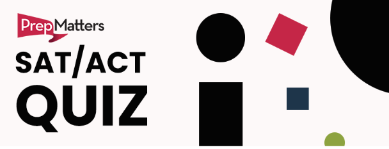Posted on: November 8, 2019
ACT Science Overview
Before discussing how to tackle science strategy, I want to note a few things about what skills the ACT science section tests. I’ll often introduce the science section as a “science” section, with a tongue-in-cheek eye roll and obvious air quotes. On the whole, it does not test whether we remember topics from science class: you won’t need to balance force vectors, recall the molar mass of copper, or understand the role of NADP+ in photosynthesis. Similarly, the test doesn’t need me to have rigorous skills of measurement, identifying confounds, causality, or pattern recognition across disciplines. The science has very little fancy stuff.
Disliking science or thinking it a weakness will not prevent you from getting a competitive score. I know this in part because my substantive knowledge of high school science is fairly weak, and it’s pretty rare that I miss an ACT Science question. In fact, my ignorance may at times help me out: I can adopt speedy, often superficial shortcuts without feeling that I “should” think more carefully about it. Inversely, if you’re among the students who pride themselves on scientific zeal or rigor, keep in mind that success on the Science section is a completely different thing than success in the classroom.
The science section of the ACT requires efficiently finding information on the page and being comfortable with uncertainty. On a few subtle questions, we need to know a handful of concepts from the scientific method and very general science knowledge: Opposite charges attract; hydration relates to water; heaters heat things. We’re not talking quantum mechanics here. More than anything, success on the ACT Science requires familiarity with the section and an intentional, efficient approach.
General Approach to the ACT Science Section
ACT Science strategy is in principle the same as our strategy on all sections: we want to do easy, fast tasks before hard, time-consuming tasks. On science, this means setting priorities both among passages and within them.
The point I emphasize most with my students is to do the “battling hypotheses” passage last (more on those later). Even if you aim to get every single question right, you’ll want to lock down the easy passages to reserve your time to think carefully during more subtle ones at the end.
Often, test strategies require developing a decision-making process for which circumstances we should use which tools. I think an analogy may help here. In setting up a kitchen for a chef, we may sometimes need a very specific tool: a sous vide cooker, ice cream maker, a potato ricer. Most of the time, though, we’ll need more general tools: a chef’s knife, a mixing bowl, a saucepot. If we have all kinds of really specific gear in the way, it can make the process inefficient and ineffective. Similarly, on the ACT science section, we want to consult the most useful and general sources of information first, then reach for more specialized, harder to use info.
Whenever I approach a Science question, I follow this order of operations:
- Look to any chart, table, or graph mentioned in the question.
- Look to any other chart, table, or graph.
- Look to the answers! (Delaying this can cost lots of time).
- Look for a word or symbol’s definition in a paragraph, especially anything offset by commas or parentheses.
- Read a paragraph on the page.
- Consult common sense or background knowledge.
Depending on your goals, you may not need to tackle every passage. Knowing what kinds of passages are on the test helps both with priority setting and choosing the most helpful process. I think of the ACT Science section as containing, broadly, three types of passages: data analysis, experiment analysis, and battling hypotheses. Let’s review them in increasing order of depth and context required … which is likely a rough proxy for their difficulty.
Data Analysis Passages
I like to give these ones the pet name “Graph & Dash.” You can call them whatever you like. “Find & Grind”?
“Case & Chase”? “Data & Ditch”? Something more serious sounding, if that’s what you’re into? Here’s how we can identify these:
- The page mostly contains tables, charts, and graphs.
- There’s little paragraph text.
- Answers are fairly short, and often quantitative (e.g., “46 amps,” rather than “spin-up, because the rotational direction of a strange quark spin must be counter that of its pair”)
- The first passage types have no subtitle divisions (Experiment 1, Study 3, etc). This is the clearest indicator.
Please, please don’t think too hard about these passages. Get right into the question, identify the value or trend the question asks about, and report it back in your answer. Much of the time, we don’t need to understand what the passage is talking about in order to get questions right. I know this sounds bizarre.
Imagine I have a task to do in Spanish. I speak very little Spanish. So little, we might as well round it to zero. I’m talking nada here. BUT, if this “Spanish” task is to take a page of Spanish and ask me to circle and count any time the text mentions the word mariposa, I can do that. I can count those symbols on the page. I don’t need to know what the text is about or what mariposa really means or why the author wrote about them instead of something else.
Yes, this skill is fairly useless one on which to judge students. I get it. It can feel unfair and arbitrary. It’s the kind of thing machines can do. It’s almost insultingly mechanized and requires little reasoning. To call it science is an insult to science. And so on. Fine, yes, you’re entirely right to resent it and judge it inane. That’s the game to play here, though.
It’s your role, in this silly game, to bubble in the right bubble to get points. Think deeply only if you need to, only if an automated, fairly thoughtless approach doesn’t give you the answer.
A word of caution, though! We do need to be very aware of the exact units that the passage reports on axes and in questions and answers. Often, these provide clues that we have found what we’re looking for, or that we need to look a value up on another figure. Returning to the silly mariposa example: I need to count every time that word appears and ONLY that word. If I am a bit too reckless, I may count the word mariquita instead and thus get the question wrong.
From time to time, we may need to look at multiple figures or reason out a simple sum, but it’s rare that we venture into the “read the passage” or “consult background knowledge” steps on these passage types.
In summary, the details matter, but the context does not.
Experiment Analysis Passages
The major issue here is that we may need to have a slightly deeper understanding of what the experiments were, how they were done, and what was measured. This in mind, I suppose we can workshop a pet name here (“Pace it & Ace it”? “When in need…read indeed”? We are best off calling these type “Experimental Analysis,” I suspect). Here’s how we recognize them:
- The page contains a mix of paragraphs and figures.
- Answers are often a bit longer (e.g., “spin-up, because the rotational direction of a strange quark spin must be counter that of its pair,” rather than “46 amps”).
- These passage types have subtitle divisions (Experiment 1, Study 3, etc.).
I suspect there’s likely to be a lot more variation in individuals’ processes on this passage type, as it mixes different levels of nuance. Some students have time to read every word. They feel they benefit from the confidence that gives them, and they are able to read it quickly and remember adequate details.
For many of us, though, there may not be time to invest this level of care. The trade-off of time for accuracy or piece of mind just isn’t worth it.
To get a sense of the context quickly, I like to read the first sentence of each paragraph and investigate the columns and axes of figures. Then, when I need to look up a complicated term, figure out how many salamanders the experiment measured, or analyze what a likely result would be of varying some attribute of the experiment, I have a decent sense of where to find the information.
Often, if a question asks me to compare two experiments, I will start by looking at the first sentence of the second experiment. It will often say something like “we did the same thing as in experiment 1, but we kept the temperature the same and changed the metal we used.” Along with knowing what kind of answer the question wants, this information can help you get your footing fairly quickly.
Battling Hypotheses Passages
Do battling hypothesis passages last!
With most portions of the ACT, I’m very deferential to students. I’ll say “humor me and try it this way for your homework. If you hate it, we’ll chat about why, and then we’ll find a way that works with your brain and helps us get questions accurately and efficiently.”
When it comes to hypotheses, though, I’m inflexibly dogmatic. Hypotheses passages are the most time-consuming and subtle passage types on the ACT Science section, and you should typically do hard, time-consuming tasks before easy, fast tasks on standardized tests.
Do hypotheses passages last. You may think another way is better, but it isn’t.
Information on the data and experiment passages is well-organized in chart, table, and graphical form. The information on the hypotheses passages is less well-organized in paragraph form. There’s far more to read on hypotheses passages. Answers are longer on the hypotheses passages. Testers are required to better understand the content on the hypothesis passage. Context matters more here, and students are a bit more likely to see questions that they have to know from “real” science.
When you do dive in, you may want to think of these more like ACT reading section passages. However you approach tasks like these, some important considerations are to minimize cognitive load (how much you need to keep in working memory and attend to at a specific time) and to minimize redundancy (such as reading text without putting it into practice, knowing the answer, but going back to check the text for added certainty). One way to accomplish these goals is as follows:
- Read background info.
- Read ONLY the first hypothesis (student or scientist 1).
- Check all questions that mention the first hypothesis and eliminate any answers that can’t work based on your knowledge of only that hypothesis.
- Read ONLY the next hypothesis.
- Check all questions that mention the next hypothesis and eliminate any answers that can’t work based on your knowledge of only that hypothesis.
- Repeat steps 4 & 5 until you’ve answered most questions.
- Think about and/or guess on any remaining questions.
Strategy for Your ACT Science Goals
The scores you’re currently getting and your target score will inform your approach to the Science section. Rather than jumping straight to the 36 strategy, work your way up, focusing on locking down the easiest questions as you refine your timing and familiarity with the test.
Getting to a 23 on the ACT Science
Look for passage 1 types and spend most of your time getting those right. Complete half the questions on the section with high confidence and guess on the rest.
Getting to a 28 on the ACT Science
Now you need to get around 75% of the questions correct. Be sure to save battling hypotheses for last and do plenty of practice to make sure you’re not “over-thinking.”
Keep moving and don’t think too hard … this is the stage in which pacing is the thing to improve. To practice speed, break sections into individual passages. Try to get all questions on a passage right in 7 minutes. Then bring it down to 6 minutes. Then to 5. Then build up, trying to do two passages in 13 minutes, then in 12, then in 10.
Don’t sweat the subtle questions too much, and no worries if you have to guess on the last 3-5 questions.
Getting to a 32 on the ACT Science
Here, you really need to put your process under the microscope, going over questions you miss on practice sections and considering which ones you could have got right by making different choices, and which ones you can live without getting right.
Getting to a 36 on the ACT Science
Now we’re really in it. I wish I could give you two sentences on perfecting your score. I can’t. What I can say is that working with the highest end of the curve can be frustrating or exhilarating, because your score might bounce around far more, because fewer questions have a high impact. Be very aware of how you’re feeling, the circumstances of the test sections you take, and the impact of these on your performance.




